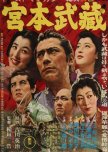Below average plot/characters; terrific ambience and cinematography
What an interesting film trilogy to review. In fact, I feel it is easier to regard this as one film with three parts, separately released. Consider this as one cumulative review for Samurai I, II, and III (I won't provide any plot spoilers).
The story takes place in the 17th century Japan. It is after the Battle of Sekigahara. Our titular character, Mushashi, leaves the small village life seeking fame as a warrior. Musashi eventually becomes a ronin, a wandering samurai, and we accompany this character on his adventures. The plot is fictional, but the character of Musashi Miyamoto is a true historical figure.
First off, I will say that I enjoyed this film, have seen it twice, and look forward to a rewatch down the road. However, it is a subpar film in terms of plot, character, acting, and music. Plot is especially laughable. The action scenes, in particular, are uninspiring and lacking. Characters present as unbelievable, one-dimensional, and some even as pathetic. Even for Toshiro Mifune, a titan in film, this is not one of his stronger performances. The only music I can recall is one heroic sounding theme that is repackaged over and over throughout the film. The dialogue, as well, is unremarkable.
The two female leads, Otsu and Akemi, are strangely compelling despite narrow character design (and even mediocre acting); compelling as in I found myself rooting for both characters. In many films portraying historical women in Japan, say in the role of geisha or romantic intrigue, I find these characters to be flat. Perhaps the presentation of Otsu and Akemi as outgoing and forward was a refreshment and something to look forward to on some level.
So, why did I enjoy this sub-par film and why would I rewatch it again?
Ambience. I suspect the film has many historical inaccuracies, but I could grasp a distinct and coherent ambience not easily felt in other period films. If you've seen many historical asian dramas, especially K-drama or C-drama, it is as if all of the historical eras over a millennia are presented in the same visual way - same court costumes, hats, sets, gardens, castles, etc. It gets tiresome seeing the same 'historical image' over and over. With the Samurai Trilogy, the film looked and felt as if it might be more like the 1600s rather than 1800s. Even though the film plot and aesthetics are fictional, the coherent ambience helped suspend my belief; I could believe I was watching people in 1600s Japan.
The natural scenery in this film was prominent and alive. Mountains, rivers, trees, rice fields, grassy meadows, etc., all looked full and wonderful. It was like being enclosed in the romantic nature and space of 17th century Japan. And for that feeling alone, I would venture back to watch this film from time to time without taking the film craft aspect too seriously.
The story takes place in the 17th century Japan. It is after the Battle of Sekigahara. Our titular character, Mushashi, leaves the small village life seeking fame as a warrior. Musashi eventually becomes a ronin, a wandering samurai, and we accompany this character on his adventures. The plot is fictional, but the character of Musashi Miyamoto is a true historical figure.
First off, I will say that I enjoyed this film, have seen it twice, and look forward to a rewatch down the road. However, it is a subpar film in terms of plot, character, acting, and music. Plot is especially laughable. The action scenes, in particular, are uninspiring and lacking. Characters present as unbelievable, one-dimensional, and some even as pathetic. Even for Toshiro Mifune, a titan in film, this is not one of his stronger performances. The only music I can recall is one heroic sounding theme that is repackaged over and over throughout the film. The dialogue, as well, is unremarkable.
The two female leads, Otsu and Akemi, are strangely compelling despite narrow character design (and even mediocre acting); compelling as in I found myself rooting for both characters. In many films portraying historical women in Japan, say in the role of geisha or romantic intrigue, I find these characters to be flat. Perhaps the presentation of Otsu and Akemi as outgoing and forward was a refreshment and something to look forward to on some level.
So, why did I enjoy this sub-par film and why would I rewatch it again?
Ambience. I suspect the film has many historical inaccuracies, but I could grasp a distinct and coherent ambience not easily felt in other period films. If you've seen many historical asian dramas, especially K-drama or C-drama, it is as if all of the historical eras over a millennia are presented in the same visual way - same court costumes, hats, sets, gardens, castles, etc. It gets tiresome seeing the same 'historical image' over and over. With the Samurai Trilogy, the film looked and felt as if it might be more like the 1600s rather than 1800s. Even though the film plot and aesthetics are fictional, the coherent ambience helped suspend my belief; I could believe I was watching people in 1600s Japan.
The natural scenery in this film was prominent and alive. Mountains, rivers, trees, rice fields, grassy meadows, etc., all looked full and wonderful. It was like being enclosed in the romantic nature and space of 17th century Japan. And for that feeling alone, I would venture back to watch this film from time to time without taking the film craft aspect too seriously.
Was this review helpful to you?







